#containerorchestration
Text
Ansible Collections: Extending Ansible’s Capabilities
Ansible is a powerful automation tool used for configuration management, application deployment, and task automation. One of the key features that enhances its flexibility and extensibility is the concept of Ansible Collections. In this blog post, we'll explore what Ansible Collections are, how to create and use them, and look at some popular collections and their use cases.
Introduction to Ansible Collections
Ansible Collections are a way to package and distribute Ansible content. This content can include playbooks, roles, modules, plugins, and more. Collections allow users to organize their Ansible content and share it more easily, making it simpler to maintain and reuse.
Key Features of Ansible Collections:
Modularity: Collections break down Ansible content into modular components that can be independently developed, tested, and maintained.
Distribution: Collections can be distributed via Ansible Galaxy or private repositories, enabling easy sharing within teams or the wider Ansible community.
Versioning: Collections support versioning, allowing users to specify and depend on specific versions of a collection. How to Create and Use Collections in Your Projects
Creating and using Ansible Collections involves a few key steps. Here’s a guide to get you started:
1. Setting Up Your Collection
To create a new collection, you can use the ansible-galaxy command-line tool:
ansible-galaxy collection init my_namespace.my_collection
This command sets up a basic directory structure for your collection:
my_namespace/
└── my_collection/
├── docs/
├── plugins/
│ ├── modules/
│ ├── inventory/
│ └── ...
├── roles/
├── playbooks/
├── README.md
└── galaxy.yml
2. Adding Content to Your Collection
Populate your collection with the necessary content. For example, you can add roles, modules, and plugins under the respective directories. Update the galaxy.yml file with metadata about your collection.
3. Building and Publishing Your Collection
Once your collection is ready, you can build it using the following command:
ansible-galaxy collection build
This command creates a tarball of your collection, which you can then publish to Ansible Galaxy or a private repository:
ansible-galaxy collection publish my_namespace-my_collection-1.0.0.tar.gz
4. Using Collections in Your Projects
To use a collection in your Ansible project, specify it in your requirements.yml file:
collections:
- name: my_namespace.my_collection
version: 1.0.0
Then, install the collection using:
ansible-galaxy collection install -r requirements.yml
You can now use the content from the collection in your playbooks:--- - name: Example Playbook hosts: localhost tasks: - name: Use a module from the collection my_namespace.my_collection.my_module: param: value
Popular Collections and Their Use Cases
Here are some popular Ansible Collections and how they can be used:
1. community.general
Description: A collection of modules, plugins, and roles that are not tied to any specific provider or technology.
Use Cases: General-purpose tasks like file manipulation, network configuration, and user management.
2. amazon.aws
Description: Provides modules and plugins for managing AWS resources.
Use Cases: Automating AWS infrastructure, such as EC2 instances, S3 buckets, and RDS databases.
3. ansible.posix
Description: A collection of modules for managing POSIX systems.
Use Cases: Tasks specific to Unix-like systems, such as managing users, groups, and file systems.
4. cisco.ios
Description: Contains modules and plugins for automating Cisco IOS devices.
Use Cases: Network automation for Cisco routers and switches, including configuration management and backup.
5. kubernetes.core
Description: Provides modules for managing Kubernetes resources.
Use Cases: Deploying and managing Kubernetes applications, services, and configurations.
Conclusion
Ansible Collections significantly enhance the modularity, distribution, and reusability of Ansible content. By understanding how to create and use collections, you can streamline your automation workflows and share your work with others more effectively. Explore popular collections to leverage existing solutions and extend Ansible’s capabilities in your projects.
For more details click www.qcsdclabs.com
#redhatcourses#information technology#linux#containerorchestration#container#kubernetes#containersecurity#docker#dockerswarm#aws
2 notes
·
View notes
Text
Kubernetes Consulting Services | Streamlining Your Cloud-Native Journey

As businesses increasingly migrate to cloud-native environments, Kubernetes has emerged as the go-to solution for container orchestration. With its powerful capabilities to automate deployment, scaling, and management of containerized applications, Kubernetes helps organizations achieve agility, scalability, and resilience. However, implementing and managing Kubernetes can be complex, requiring specialized expertise and experience. This is where Kubernetes consulting services come in.
What Are Kubernetes Consulting Services?
Kubernetes consulting services provide businesses with expert guidance to effectively design, implement, and manage Kubernetes environments. These services help companies navigate the complexities of Kubernetes to optimize their cloud-native strategies, whether they are just starting with Kubernetes or looking to scale their existing infrastructure.
Key offerings in Kubernetes consulting services typically include:
Architecture Design and Implementation: Tailored guidance on designing and deploying Kubernetes clusters that align with your business requirements.
Security and Compliance: Ensuring your Kubernetes environment is secure and compliant with industry standards and regulations.
Performance Optimization: Fine-tuning Kubernetes deployments for maximum efficiency and performance, including monitoring and troubleshooting.
Migration Services: Seamless migration of applications from legacy systems or other container platforms to Kubernetes.
DevOps Integration: Integrating Kubernetes with your existing DevOps workflows and CI/CD pipelines to enhance automation and collaboration.
Why You Need Kubernetes Consulting Services
Accelerated Deployment: A Kubernetes consultant can expedite the deployment process, reducing time-to-market for your applications.
Cost Efficiency: By optimizing resources and minimizing misconfigurations, consulting services help in reducing operational costs associated with Kubernetes management.
Enhanced Security: Consultants ensure your Kubernetes clusters are set up with best-in-class security practices, protecting your data and applications.
Scalability and Flexibility: Expert guidance enables you to build a scalable Kubernetes architecture that adapts to changing business needs.
Continuous Support: Beyond initial deployment, consultants provide ongoing support to manage updates, troubleshoot issues, and optimize performance.
How Feathersoft Info Solutions Can Help
At feathersoft info solutions, we provide comprehensive Kubernetes consulting services to help you navigate the complexities of container orchestration. Our team of certified Kubernetes experts will work closely with your IT team to design, deploy, and manage a Kubernetes environment that aligns with your strategic objectives. We offer end-to-end services, from initial assessment and architecture design to ongoing support and optimization, ensuring your Kubernetes deployment is efficient, secure, and scalable.
Benefits of Choosing Feathersoft Info Solutions for Kubernetes Consulting
Tailored Solutions: We customize our approach to meet your unique business requirements and cloud strategy.
Expert Team: Our consultants are seasoned professionals with extensive experience in deploying and managing Kubernetes in diverse environments.
Proven Methodologies: We follow industry best practices to ensure your Kubernetes implementation is robust, secure, and compliant.
Continuous Support: Our services don’t end with deployment; we offer ongoing support to ensure your Kubernetes environment continues to perform optimally.
Conclusion
Kubernetes consulting services are essential for businesses looking to unlock the full potential of cloud-native technologies. By partnering with experts like feathersoft info solutions, you can ensure a smooth Kubernetes adoption, optimize performance, and stay ahead in today’s fast-paced digital landscape. Don’t let the complexities of Kubernetes slow down your innovation—invest in professional consulting services and accelerate your cloud-native journey.
#Kubernetes#CloudNative#DevOps#ContainerOrchestration#CloudComputing#KubernetesConsulting#ITConsulting#DigitalTransformation#Microservices#CloudStrategy#KubernetesSecurity#TechSolutions#CloudInfrastructure
0 notes
Text
#ContainerServices#ContainerOrchestration#Kubernetes#CloudComputing#DevOps#ContainerSecurity#MultiCloud#HybridCloud#EdgeComputing#ContainerManagement#CloudInfrastructure#ContainerTech#Docker#Microservices#CI_CD#TechTrends#DigitalTransformation#AIinTech#MLinTech#StartupTech
0 notes
Text
Understanding Container Orchestration: A Beginner’s Guide
Introduction to Container Orchestration
In today's digital era, efficiently managing complex applications composed of multiple containers with unique requirements and dependencies is crucial. Manually handling and deploying a growing number of containers can result in errors and inefficiencies. Container orchestration emerges as a vital solution to these challenges.
Defining Container Orchestration
Container orchestration automates the deployment, management, scaling, and networking of containers. Containers are lightweight, isolated environments that package applications and their dependencies, ensuring seamless operation across diverse computing environments.
With numerous containers representing different parts of an application, orchestration is essential to deploy these containers across various machines, allocate appropriate resources, and facilitate communication between them. It's akin to a conductor leading an orchestra. Without orchestration, managing containers would be chaotic and inefficient.
Popular container orchestration tools include Kubernetes and Docker Swarm.
The Importance of Container Orchestration
Managing containers in a production environment can quickly become complex, especially with microservices—independent processes running in separate containers. Large-scale systems can involve hundreds or thousands of containers. Manual management is impractical, making orchestration essential. It automates tasks, reducing operational complexity for DevOps teams who need to work quickly and efficiently.
Advantages of Container Orchestration
Streamlined Application Development: Orchestration tools accelerate the development process, making it more consistent and repeatable, ideal for agile development approaches like DevOps.
Scalability: Easily scale container deployments up or down as needed. Managed cloud services provide additional scalability, enabling on-demand infrastructure adjustments.
Cost-Effectiveness: Containers are resource-efficient, saving on infrastructure and overhead costs. Orchestration platforms also reduce human resource expenses and time.
Security: Manage security policies across different platforms, minimizing human errors and enhancing security. Containers isolate application processes, making it harder for attackers to infiltrate.
High Availability: Quickly identify and resolve infrastructure failures. Orchestration tools automatically restart or replace malfunctioning containers, ensuring continuous application availability.
Productivity: Automate repetitive tasks, simplifying the installation, management, and maintenance of containers, allowing more focus on developing applications.
How Container Orchestration Works
Using YAML or JSON files, container orchestration tools like Kubernetes specify how an application should be configured. These configuration files define where to find container images, how to set up the network, and where to store logs.
When deploying a new container, the orchestration tool determines the appropriate cluster and host based on specified requirements. It then manages the container's lifecycle according to the defined configurations.
Kubernetes patterns facilitate the management of container-based applications' configuration, lifecycle, and scalability. These patterns are essential tools for building robust systems with Kubernetes, which can operate in any container-running environment, including on-premise servers and public or private clouds.
Container Orchestration Using Kubernetes
Kubernetes, an open-source orchestration platform, is widely adopted for building and managing containerized applications and services. It allows easy scaling, scheduling, and monitoring of containers. As of 2022, 96% of Sysdig global customer containers are deployed on Kubernetes.
Other container orchestration options include Apache Mesos and Docker Swarm, but Kubernetes is favored for its extensive container capabilities and support for cloud-native application development. Kubernetes is also highly extensible and portable, compatible with advanced technologies like service meshes. Its declarative nature enables developers and administrators to define desired system behaviors, which Kubernetes then implements in real-time.
Conclusion
Container orchestration is a transformative approach to designing and managing applications. It simplifies deployment processes, enhances scalability, improves security, and optimizes resource utilization. As the industry evolves, adopting orchestration is crucial for organizations aiming to innovate and deliver exceptional software solutions.

0 notes
Text
Explore the world of cloud hosting with Digital Ocean: Droplets, Kubernetes, and more, brought to you by Coupon Stopper. Dive into the versatility and scalability of Digital Ocean's cloud infrastructure, including Droplets for reliable virtual machines and Kubernetes for seamless container orchestration. Learn how Digital Ocean empowers developers and businesses with flexible solutions tailored to their unique needs. From deploying web applications to managing data workloads, Coupon Stopper's guide covers everything you need to know about leveraging Digital Ocean's cloud services effectively. Stay ahead in the digital landscape with Digital Ocean and Coupon Stopper.
#DigitalOcean#CloudHosting#Droplets#Kubernetes#CouponStopper#Infrastructure#VirtualMachines#ContainerOrchestration#Developers#Businesses
0 notes
Text
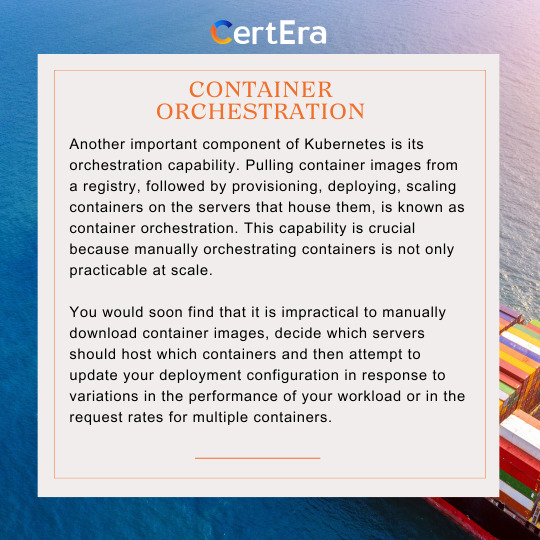
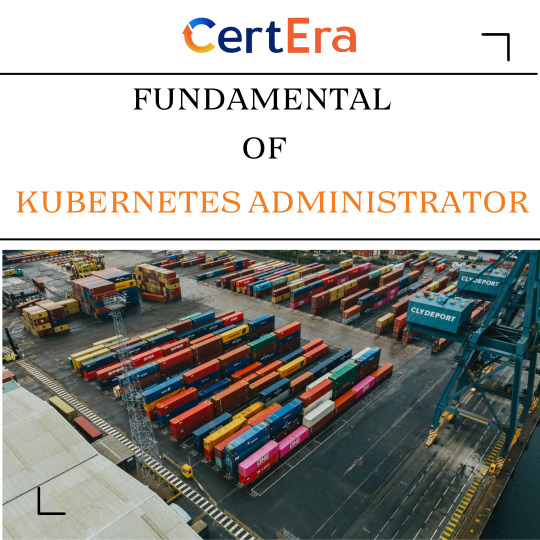
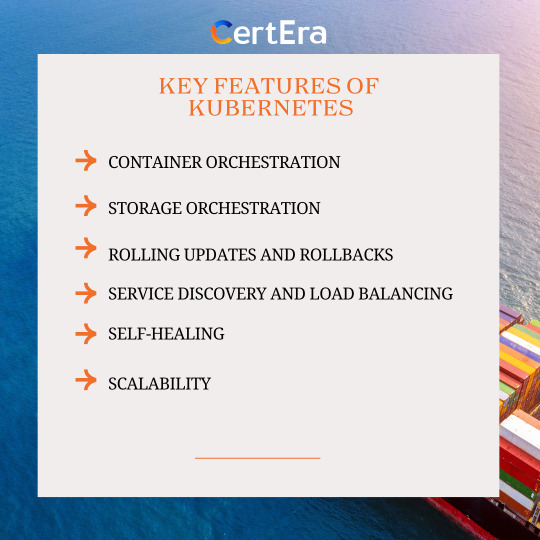
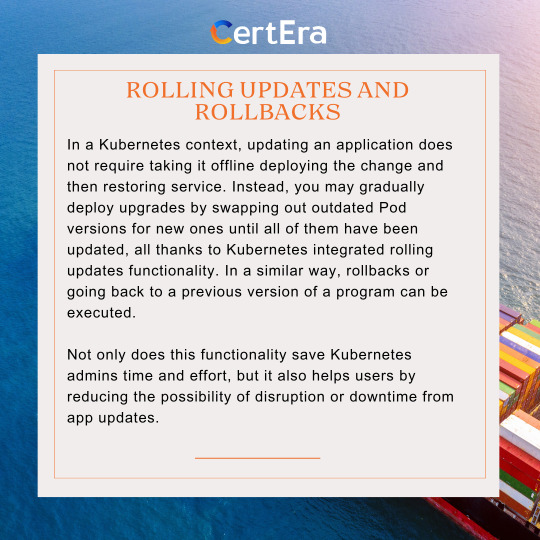


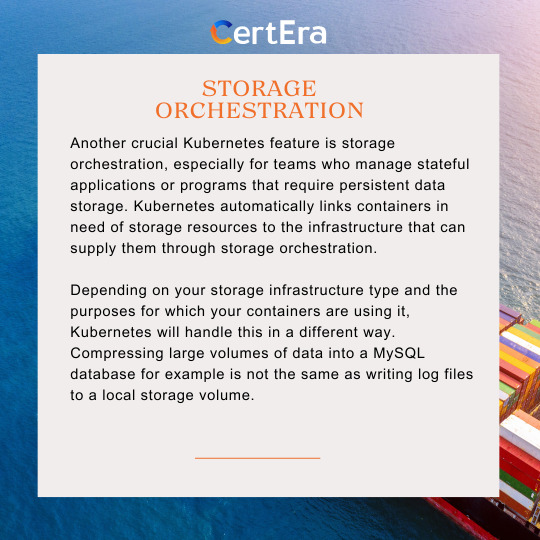

"Master Kubernetes Administrator: Managing clusters, orchestrating containerized apps, and guaranteeing efficiency, scalability, and resilience. knowledgeable with the architecture and use of Kubernetes."
#KubernetesAdmin#K8sAdmin#KubernetesAdministrator#K8sAdministrator#KubernetesFundamentals#K8sBasics#ContainerOrchestration#DevOps#CloudNative#KubernetesOps#SysAdmin#InfrastructureAsCode#CloudComputing#Kubernetes101#certera
0 notes
Text
TikTok parent company creates KubeAdmiral for Kubernetes

While Kubernetes is still the de-facto standard in container orchestration, a lot of people who work on it would agree that it is in fact quite hard and in need of a lot of polishing.
Read More. https://www.sify.com/cloud/tiktok-parent-company-creates-kubeadmiral-for-kubernetes/
#KubeAdmiral#TikTok#Kubernetes#Container#PublicCloud#PrivateCloud#KubeFed#ByteDance#Cluster#ContainerOrchestration
0 notes
Text
Hey there, cloud-native enthusiasts! Today, we’re diving into one of my favourite topics: Kubernetes Operators. These aren’t just tools; they’re game-changers in cloud-native application management. Let’s unravel the mystery of Operators and explore why they’re essential for anyone venturing into Kubernetes.
#Kubernetes#CloudNative#ContainerOrchestration#Operators#DevOps#Containerization#CloudComputing#Microservices#Automation#InfrastructureAsCode#ApplicationManagement#DevOpsTools#ContainerDeployment#CloudTechnology#ClusterManagement
0 notes
Text
The role of containerization in DevOps, and what are some popular containerization tools?
Containerization plays a crucial role in DevOps by providing a consistent and isolated environment for applications and their dependencies. Containers package applications and all required libraries and settings into a single, lightweight unit, making it easier to deploy, scale, and manage applications across different environments. Here’s a more detailed look at the role of containerization in…
View On WordPress
#Consistency#ContainerDeployment#Containerization#ContainerizationTrends#ContainerManagement#ContainerOrchestration#ContainerRegistries#ContainerSecurity#DevOps#DevOpsPractices#DevOpsTools#Docker#DockerHub#Isolation#Kubernetes#Microservices#OCI#Portability#Scalability
0 notes
Photo

Got spirit?
0 notes
Text
Unleashing Efficiency: Containerization with Docker
Introduction: In the fast-paced world of modern IT, agility and efficiency reign supreme. Enter Docker - a revolutionary tool that has transformed the way applications are developed, deployed, and managed. Containerization with Docker has become a cornerstone of contemporary software development, offering unparalleled flexibility, scalability, and portability. In this blog, we'll explore the fundamentals of Docker containerization, its benefits, and practical insights into leveraging Docker for streamlining your development workflow.
Understanding Docker Containerization: At its core, Docker is an open-source platform that enables developers to package applications and their dependencies into lightweight, self-contained units known as containers. Unlike traditional virtualization, where each application runs on its own guest operating system, Docker containers share the host operating system's kernel, resulting in significant resource savings and improved performance.
Key Benefits of Docker Containerization:
Portability: Docker containers encapsulate the application code, runtime, libraries, and dependencies, making them portable across different environments, from development to production.
Isolation: Containers provide a high degree of isolation, ensuring that applications run independently of each other without interference, thus enhancing security and stability.
Scalability: Docker's architecture facilitates effortless scaling by allowing applications to be deployed and replicated across multiple containers, enabling seamless horizontal scaling as demand fluctuates.
Consistency: With Docker, developers can create standardized environments using Dockerfiles and Docker Compose, ensuring consistency between development, testing, and production environments.
Speed: Docker accelerates the development lifecycle by reducing the time spent on setting up development environments, debugging compatibility issues, and deploying applications.
Getting Started with Docker: To embark on your Docker journey, begin by installing Docker Desktop or Docker Engine on your development machine. Docker Desktop provides a user-friendly interface for managing containers, while Docker Engine offers a command-line interface for advanced users.
Once Docker is installed, you can start building and running containers using Docker's command-line interface (CLI). The basic workflow involves:
Writing a Dockerfile: A text file that contains instructions for building a Docker image, specifying the base image, dependencies, environment variables, and commands to run.
Building Docker Images: Use the docker build command to build a Docker image from the Dockerfile.
Running Containers: Utilize the docker run command to create and run containers based on the Docker images.
Managing Containers: Docker provides a range of commands for managing containers, including starting, stopping, restarting, and removing containers.
Best Practices for Docker Containerization: To maximize the benefits of Docker containerization, consider the following best practices:
Keep Containers Lightweight: Minimize the size of Docker images by removing unnecessary dependencies and optimizing Dockerfiles.
Use Multi-Stage Builds: Employ multi-stage builds to reduce the size of Docker images and improve build times.
Utilize Docker Compose: Docker Compose simplifies the management of multi-container applications by defining them in a single YAML file.
Implement Health Checks: Define health checks in Dockerfiles to ensure that containers are functioning correctly and automatically restart them if they fail.
Secure Containers: Follow security best practices, such as running containers with non-root users, limiting container privileges, and regularly updating base images to patch vulnerabilities.
Conclusion: Docker containerization has revolutionized the way applications are developed, deployed, and managed, offering unparalleled agility, efficiency, and scalability. By embracing Docker, developers can streamline their development workflow, accelerate the deployment process, and improve the consistency and reliability of their applications. Whether you're a seasoned developer or just getting started, Docker opens up a world of possibilities, empowering you to build and deploy applications with ease in today's fast-paced digital landscape.
For more details visit www.qcsdclabs.com
#redhat#linux#docker#aws#agile#agiledevelopment#container#redhatcourses#information technology#ContainerSecurity#ContainerDeployment#DockerSwarm#Kubernetes#ContainerOrchestration#DevOps
2 notes
·
View notes
Link
Successful & Short Kubernetes Stories For DevOps Architects by @Pavan_Belagatti https://t.co/FkRMt7Ayb5 #kubernetes #cloudnative #devops #successstories #softwarearchitecture #containerorchestration
— Developer's Espresso (@CodersEspresso) January 2, 2020
via: https://ift.tt/1GAs5mb
0 notes
Link
Container orchestration market size, analysis, trends, & forecasts. The global market for container orchestration categorized by platform, services, organization size, vertical & region.
0 notes
Text
Enhancing IT Performance with HawkStack's Infrastructure & Monitoring Solutions
In today’s fast-paced digital world, businesses rely heavily on the strength and efficiency of their IT infrastructure. For organizations striving to stay ahead, it’s critical to have a robust and high-performance infrastructure paired with modern monitoring systems. This is where HawkStack Technologies excels.
Tailored Infrastructure Solutions
HawkStack Technologies understands that no two businesses are the same. We provide customized infrastructure solutions designed to meet the specific needs of your organization. From scalable cloud-based environments to on-premise servers, we ensure your infrastructure is optimized for both performance and cost-efficiency.
Proactive Management
Our team of experts is dedicated to ensuring that your infrastructure is running smoothly at all times. With HawkStack's proactive management services, we address potential issues before they become critical, minimizing downtime and maintaining peak performance.
Modern Monitoring for Quick Issue Resolution
The key to seamless operations is effective monitoring. HawkStack Technologies integrates modern monitoring tools that provide real-time insights into your systems. This allows for quick detection and resolution of any issues, ensuring your IT environment remains healthy and your business operations stay uninterrupted.
Why HawkStack?
By choosing HawkStack, you are investing in a solution that evolves with your business. We prioritize long-term scalability, security, and operational efficiency, enabling your IT environment to grow alongside your business needs.
Stay ahead of the curve with HawkStack's tailored infrastructure solutions and modern monitoring services. For more details, visit www.hawkstack.com.
Let HawkStack power your business to new heights
#redhatcourses#information technology#containerorchestration#docker#container#kubernetes#linux#containersecurity#hawkstack#hawkstack technologies
0 notes
Text
Maximizing Uptime with Proactive Monitoring: The Future of Operations Management
In today's fast-paced digital landscape, uninterrupted operations are the cornerstone of business success. The key to achieving this? Proactive monitoring. By leveraging cutting-edge tools and AI-powered analytics, proactive monitoring goes beyond traditional approaches, ensuring your systems run smoothly while minimizing the risk of downtime.
What Is Proactive Monitoring?
Proactive monitoring refers to the practice of continuously observing system performance, identifying potential issues, and resolving them before they escalate into major disruptions. Unlike reactive monitoring, which addresses problems after they occur, proactive monitoring anticipates issues and acts ahead of time, safeguarding your operations.
The Role of AI in Proactive Monitoring
AI-powered analytics play a crucial role in proactive monitoring by:
Detecting Anomalies: With machine learning algorithms, AI can recognize patterns and detect anomalies that might be early signs of a system failure.
Predicting Issues: Based on historical data and real-time monitoring, AI can predict when and where problems might arise, allowing for preventive action.
Automating Responses: AI not only identifies problems but can also automate responses, mitigating issues without human intervention.
Benefits of Proactive Monitoring
Minimized Downtime: By addressing bottlenecks and vulnerabilities before they cause disruptions, proactive monitoring helps ensure continuous operations.
Enhanced Performance: Regularly monitoring system health improves performance, leading to smoother workflows and higher productivity.
Cost Savings: Preventing issues early on reduces the need for costly emergency fixes and minimizes the impact of downtime on revenue.
Scalability: As your business grows, proactive monitoring helps ensure your systems can handle increased workloads and complex processes without compromising efficiency.
Proactive Monitoring: A Business Imperative
In a world where system failures can result in significant revenue loss and reputational damage, proactive monitoring is more than just an operational strategy—it's a business imperative. By investing in advanced monitoring tools and AI-driven analytics, companies can stay ahead of potential risks, ensuring maximum system resilience and long-term success.
For more details click www.hawkstack.com
#redhatcourses#containerorchestration#information technology#docker#container#kubernetes#dockerswarm#hawkstack technologies#hawkstacktechnologies
0 notes